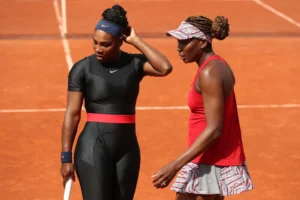Dress Codes: Why do tennis players wear white
Tennis whites are a centuries-old tradition that are pure, crisp, and entirely white. In addition to making the racquet sport stand out, its striking appearance has made it a fixture of off-court fashion as well.
And Wimbledon, the first major tournament, has stuck to its rigorous rules, as have several private clubs throughout the world, even if the majority of them have abandoned the colorless uniformity. A decade ago, the prestigious championship even strictly enforced the restriction, banning bright accents that were becoming more and more popular. This was the year that Roger Federer’s now-famous orange-soled sneakers were banned following his first round in 2013.
Originally, the regulations stipulated that clothing had to be “predominantly white,” although some contestants were free to experiment with color schemes. One such example is Serena Williams’ 2010 tribute to the Wimbledon dessert of strawberries and cream. However, the organizers claim that the government modified the phrase to “almost entirely white”—that is, no off-white, no colored panels, and no different hues of footwear. The sole recent relaxation of the regulations occurred in 2023, when it was decided to permit women to wear dark shorts on the court in response to complaints that the regulations did not account for menstrual leaks.
At Wimbledon 2024, Naomi Osaka donned a playful spin on the tennis attire, following the tournament’s all-white, minimal logo regulation (with the new exemption of dark-colored shorts for women).
Getty Images/Robert Prange
Following his first-round match in 2013, Roger Federer’s orange-soled Nike sneakers were banned from Wimbledon, and the following year the regulations regarding color accents were strengthened.
Brunskill, Clive/Getty Images
However, why did tennis whites end up being the norm? Practical explanations are frequently given, such as heat reflection and perspiration concealing. But according to senior curator Kevin Jones of the Fashion Institute of Design & Merchandising (FIDM) museum in Los Angeles, who organized the recent traveling exhibition “Sporting Fashion: Outdoor Girls 1800 – 1960,” the root of the issue is a long history of clubs enforcing social status, beginning with the rise in popularity of lawn tennis as a leisure activity that was uncommon for women to participate in during the Victorian era in Victorian-era England.
In a phone conversation with CNN, he claimed, “It’s completely elitist because white clothes are difficult to maintain.” “Maintaining the dresses’ crease-free quality was also important because the cotton and linen materials used to make them were prone to wrinkling.”
Defying the regulations
Naturally, tennis has evolved significantly in the 150 years since it was initially introduced as a ritzy pastime for the upper class, directly after croquet (and on the same immaculately manicured fields). Early tennis clothing was more in line with 19th-century leisure wear: males wore sweaters, button-down shirts, and wool slacks, and ladies wore long skirts, corsets, and wide-brimmed hats.
Fashion and tennis have had a “mutual exchange over time, where various tennis trends have seeped into wider culture as well,” according to sports journalist Ben Rothenberg, the author of “Tennis: The Stylish Life” and a recent biography on Naomi Osaka. This is because players and spectators have frequently adhered to similar styles.
Because she could move more freely on the court and because of her shorter hemlines and headscarves, Suzanne Lenglen rose to prominence as a player and became a fashion icon.
George Rinhart/Getty Images/Corbis
This has been made abundantly clear in recent months as Zendaya has been showcasing a range of high-end red carpet ensembles inspired by tennis that perfectly complement the drama unfolding on and off the court in the movie “Challengers.” She has also recently engaged in a “air tennis” battle with Federer as part of a promotion for the sportswear company On. Close ties to fashion have also contributed to the success of tennis’s iconic brands, like Lacoste and Fred Perry, as well as the introduction of daring new looks on the court, such as Elsa Schiaparelli’s shocking 1931 Wimbledon outfit of Spanish player Lilí de Álvarez, which featured split skirts called culottes.
Tennis dress standards have been adjusted following an initial scandal, as was the case with De Álvarez. One of the first and most famous examples was the French player Suzanne Lenglen, who at Wimbledon in 1919 eschewed lengthy, layered gowns in favor of a more breezy calf-length skirt and shorter sleeves. Lenglen, a fashion icon in tennis history, was a muse to designer Jean Patou and gained notoriety for her daring shorter hems and characteristic headwear.
Forty years before Serena Williams stirred controversy with a same cut at the French Open, Anne White was barred from donning a white catsuit at Wimbledon.
A classic Wimbledon courtside delight is strawberries and cream, but Williams’ 2010 homage would not pass muster today due to the ban on off-white clothing and the color-accented footwear.
Ian Kington/Getty Images and AFP
Thanks to more lenient regulations, players have questioned what constitutes appropriate tennis attire at the US, French, and Australian Opens (subject to referee opinion). Few have done so more than the Williams sisters, Venus’s delicate black-and-red attire evoking thoughts of lingerie, and Serena’s denim mini, tutus, and cape-like designs.
More recently, when Serena Williams chose to wear a black compression catsuit instead of the required tennis skirt at the 2018 French Open, her Nike outfit became the talk of the town. The French Open said it will prohibit the style going forward, despite the fact that she mentioned its benefits for circulation after having a serious blood clot scare during the birth of her kid. But once the Women’s Tennis Association officially approved it, Williams wore variations of the bodysuit in the Australian Opens in 2019 and 2021, normalizing the quick and uncomplicated cut for the tennis court.
At the 2018 French Open, Serena and Venus Williams were seen on the court. Although the Women’s Tennis Association changed its regulations to allow leggings without skirts, the event declared that catsuits would not be allowed in subsequent editions.
Getty Images/Matthew Stockman
In April, she told CNN, “I love wearing skirts,” as she considered the situation. “Yet, I had a near-death experience and I wanted to make sure my blood was always flowing.”
“There ought to have been a certain level of understanding regarding that entire ensemble,” she continued.
Differentiating brands
Decades ago, the majority of Grand Slam events abandoned their all-white restrictions, probably in an effort to draw in more TV viewers and sponsors during a period when the sport was becoming more well-known.
According to James, color is essential for drawing attention, particularly for sports companies who want to use it to promote their logos and hues.
Sports and luxury firms use fashion to advertise in a variety of ways, from dressing up top players in unique outfits to putting their merchandise on rival teams.
According to Rothenberg, manufacturers attempting to promote their championship collections have found Wimbledon’s stringent regulations to be “frustrating.” Wimbledon officials claimed they no longer followed the regulations when Fila presented Bjorn Borg throwback shirts in 2001, which were replicas of what the tennis player wore during his five-year winning streak from 1976 to 1980. According to Rothenberg, the move caused the sports brand to “scramble” to get the athletes who were wearing the old shirts new ones. Additionally, Nike had to move quickly to promote Federer’s fleeting appearance as “One Match Wonders” in a print advertisement after his orange-soled sneakers were outlawed.
Because of the stringent all-white regulation, Andre Agassi skipped Wimbledon from 1988 to 1990. However, he did attend in 1991 wearing orange clothing.
Getty Images/PA Images/Rebecca Naden
Even minor breaches have caused controversy among players, and some have simply chosen not to participate, like Andre Agassi did when he boycotted Wimbledon completely in 1988–1990. When Jurij Rodionov’s blue underwear showed through his shirts in 2017, someone advised him to change it. More recently, Sabine Lisicki claimed that ladies like herself were frequently told to change their skin-colored bras.
However, Rothenberg believes that Wimbledon’s decision-makers won’t be becoming any more forgiving anytime soon.
He clarified, “I believe Wimbledon views its anachronisms as a big part of its brand and its value.” “Wimbledon has stuck with it as a means of being unique and distinctive, and I believe it’s mostly worked out. It doesn’t appear to be like any other competition.
The big tournaments have come under fire when it appears that female players are disproportionately impacted by their dress codes. Rothenberg acknowledges this, but he also notes that women’s fashions have evolved into something more unique. Since their introduction, men’s tennis attire has strayed less from light-colored, short-sleeved athletic shirts and shorts.
He laughed and continued, “Over the last 12 months, there’s been a lot of men’s shorts getting markedly shorter, especially players who really have hiked up their shorts a lot.”
“If they start being too cheeky, maybe there will be rules against that someday.”







